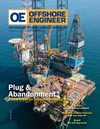
Page 55: of Offshore Engineer Magazine (Sep/Oct 2019)
Big Data and Digitalization
Read this page in Pdf, Flash or Html5 edition of Sep/Oct 2019 Offshore Engineer Magazine
TECH FILES Subsea Batteries down to the individual cell voltage lev- kilowatts at peak demand. The system the load. Each Diode ORing string can el, and in real-time. con? guration was 17 series string of provide standalone power at the DC
In a subsea oil and gas installation, 37-volt battery modules connected in voltage even if one goes down. In that it is necessary to power workover con- two parallel strings by Diode ORing case, the max capacity per string will be trols, chokes, valves, blowout preven- Modules, providing 629 volts nominal, less than the total capacity from com- ters and well heads, among other equip- 56 amp hour nominal capacity, and 400 bined strings, but will still provide the ment. Requirements include electronic amps peak current. This subsea bat- required system voltage.
control, valve control, electrical drives, tery system is currently in testing and SWE SeaSafe Direct modules power primary and backup power, more preci- performing as planned. When released, the applications for the Teledyne Marine sion, condition-based monitoring, and it promises to be a leader in safe and SeaRaptor, an AUV approximately 5.5 long-life sensors. Batteries used in such ef? cient condition-based monitoring meters long, which includes acoustic applications must deliver safety, more subsea infrastructure. modems, ascent and descent weight re- capacity, smaller size, less weight, lon- Multiple SWE SeaSafe II battery sys- leases, a black box pinger locator, sub- ger life and high reliability with on de- tems with 188-kilowatt power each are bottom pro? ler, multi-beam echosound- mand data reporting. in production for a subsea chemical in- ers, obstacle avoidance multi-beam
An electric motor for a hydraulic pump jection unit. This battery system will dra- sonar, Doppler velocity log, current, may require a high-power surge exceed- matically reduce or eliminate the copper temperature, depth sensor and onboard ing 100,000 watts for operations lasting wire demand for the umbilical. The bat- processing software. only a matter of minutes. This could tery packs will deliver suf? cient power SeaRaptor has a maximum speed over serve subsea chemical injection unit and density to run 120 barrels of MEOH at 4 knots. While its endurance depends on provide subsea local power for hydraulic 1,034 bars and 15,000 psi for six hours. speed and the exact con? guration of the pressure on demand instead of hydraulic Subsea robotics, such as AUVs, re- AUV, the SeaRaptor can typically sur- pressure furnished through an expensive quire longer survey runs, deeper dives, vey for 24 hours at 3 knots with a stan- umbilical or by bulky accumulators that with more simultaneous types of sensor dard con? guration. The standard battery both get more burdensome and costly the and scanner technology. Pressure toler- con? guration comprises 13- to 16-kilo- deeper you go in subsea operations. ant battery packs, such as SWE SeaSafe watt-hour lithium-ion rechargeable
SWE SeaSafe II and SeaSafe Direct II and SeaSafe Direct, can provide long- SWE SeaSafe Direct modules. The ve- battery modules can provide power so- term power needs by eliminating the hicle’s operating criteria require the bat- lutions as deep as 6,000 meters. Mod- weight and cost of a pressure vessel for teries to power all of the AUV functions. ules can be con? gured in higher series the batteries. The AUV needs to power The ability to change batteries with ease module strings for higher con? gured thrusters, small electric motors for servo without recon? guring the SeaRaptor is system DC voltage. Parallel strings control and actuation of manipulators, critical for ef? cient mission execution. provide higher current and thus higher digital cameras plus the lighting to en- While the SeaRaptor is in the water, power at the con? gured DC voltage. hance video and still photos, control a second set of battery modules can
Battery system reliability is enhanced processors and interface electronics, recharge in about 4 hours, thus provid- via redundancy of power available at the sensors and scanners for measurement ing the AUV the capability to quickly system DC voltage because each Diode and feedback of node status information change batteries topside and continue its
ORing string can provide standalone to the control processors. Furthermore, operation ? awlessly. power at the DC voltage even if another the AUV also needs to power commu- The industry is in the midst of a subsea string goes down. The max current per nications systems to issue commands, electric revolution that will see electric string will be less than the total current manually pilot if in hybrid ROV mode, robotic vehicles and infrastructure per- from combined strings, but will still or communicate feedback, whether vi- forming underwater tasks. The reason for provide the same voltage. Parallel cop- sually or through data communication. this is simple: industry experts recognize ies of the voltage string can also provide SeaSafe battery packs can be con? g- electric motors and robotics are more high burst current for high instantaneous ured in low count series module strings ef? cient and cost effective in subsea ap- power needs. This parallel battery mod- for low to moderate DC voltage with plications than hydraulic systems due to ule string inter-connect is facilitated by parallel copies of the voltage string to advances in technology and miniaturiza- the SWE SeaSafe Diode ORing Module. provide higher capacity of amp hours tion. Couple that with condition-based
For example, SWE supplied a Sea- and redundancy of battery voltage for monitoring bene? ts that are inherent in
Safe II Battery system for a subsea reliability. Parallel strings can be in- electric systems and then the ef? cient, electric motor hydraulic pump power terconnected on output via the Diode safe, and reliable subsea systems of the drive that required a maximum of 250 ORing Module for common output to future will be substantially electric.
SEPTEMBER/OCTOBER 2019 OFFSHORE ENGINEER 55

 54
54

 56
56